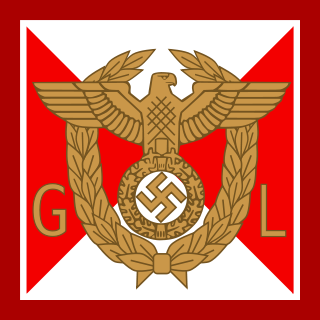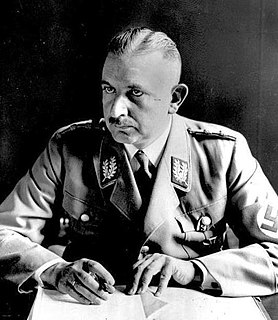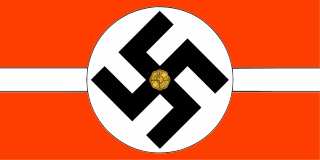Führer is a German word meaning "leader" or "guide". As a political title it is associated with the Nazi dictator Adolf Hitler.

A Gauleiter was a regional leader of the Nazi Party (NSDAP) who served as the head of a Gau or Reichsgau. Gauleiter was the third-highest rank in the Nazi political leadership, subordinate only to Reichsleiter and to the Führer himself. The position was effectively abolished with the fall of the Nazi regime on 8 May 1945.
In the military, a political commissar or political officer is a supervisory officer responsible for the political education (ideology) and organization of the unit to which they are assigned, with the intention of ensuring political control of the military.

The uniforms and insignia of the Schutzstaffel were paramilitary ranks and uniforms used by the Schutzstaffel (SS) between 1925 and 1945 to differentiate that organization from the regular German armed forces, the German state, and the Nazi Party.

Reichsführer-SS was a special title and rank that existed between the years of 1925 and 1945 for the commander of the Schutzstaffel (SS). Reichsführer-SS was a title from 1925 to 1933, and from 1934 to 1945 it was the highest rank of the SS. The longest-serving and most noteworthy office holder was Heinrich Himmler.

Ranks and insignia of the Nazi Party were paramilitary titles used by the National Socialist German Workers' Party (NSDAP) between approximately 1928 and the fall of Nazi Germany in 1945. Such ranks were held within the political leadership corps of the Nazi Party, charged with the overseeing of the regular Nazi Party members.

Karl Holz was a German Nazi Party politician. He was Gauleiter of Gau Franconia and rose to the rank of Gruppenführer in the Sturmabteilung (SA).
Hermann Muhs was a German lawyer and Nazi Party politician who served as State Secretary and leader of the Reich Ministry for Church Affairs in Nazi Germany.
Zellenleiter was a Nazi Party political title which existed between the years of 1930 and 1945. A Zellenleiter was higher in rank than a Blockleiter and was in charge of a "Nazi Cell", composed of eight to twelve city blocks.
Hubert Eisner was an Austrian Nazi and became Kreisleiter of Voitsberg.
Abteilungsleiter, German for department head, was also a mid-level administrative political position of the Nazi Party, often held by staff political officers attached to various Gaue throughout Germany. The position of Abteilungsleiter was not an actual Nazi Party political rank, but a title held by a Party member in addition to their formal rank. The position was first created in 1933, after the Nazis had secured power in Germany.

Kreisleiter was a Nazi Party political rank and title which existed as a political rank between 1930 and 1945 and as a Nazi Party title from as early as 1928. The position of Kreisleiter was first formed to provide German election district coordination and, after the Nazi assumption of power, the position became one of county municipal government, effectively replacing the traditional German government establishment.

Befehlsleiter was a Nazi Party political rank of Nazi Germany.

Stellenleiter was a Nazi Party political rank which existed between 1933 and 1938. The rank was created as a mid-level political position intended to replace the older rank of Zellenwart, also known as Zellenleiter. In the early Nazi Party rank organization, the position of Stellenleiter was senior to Mitarbeiter and junior to Amtsleiter.

Gemeinschaftsleiter was a Nazi Party political rank which existed between 1939 and 1945. Created primary to replace the older rank of Stützpunktleiter, the rank of Gemeinschaftsleiter was often used on the local level of the Nazi Party to denote the second in command of a municipal region, answering to a regional Nazi known by the title of Ortsgruppenleiter.

Bereitschaftsleiter was a Nazi Party political rank which existed between 1939 and 1945. There were three levels of the rank, known as Bereitschaftsleiter, Oberbereitschaftsleiter, and Hauptbereitschaftsleiter.

Fritz Wächtler was a Nazi Party official and politician who served as the Gauleiter of the eastern Bavarian administrative region of Gau Bayreuth. Trained as a primary school teacher, he also became head of the National Socialist Teachers League (NSLB) in 1935. During World War II he held the honorary rank of SS-Obergruppenführer and was the Reich Defense Commissioner of Gau Bayreuth. Prone to alcoholic outbursts and unpopular with the local residents, he eventually ran afoul of Martin Bormann in a political intrigue. Wächtler was executed on orders from Führer Headquarters near the end of the war on 19 April 1945.

Wilhelm (Willi) Friedrich Adolf Ritterbusch, was a German National Socialist German Workers' Party (NSDAP-NaziParty) political functionary. Among other positions, he was the German Generalkommissar zur Besonderen Verwendung, directing the political affairs and propaganda in the occupied Netherlands from the middle of July 1943 until 7 May 1945, the end of World War II.
Erich Schmiedicke was a German Nazi Party official and politician.

Bezirksleiter was a Nazi Party title which was used in the early years of the Party's existence, beginning around 1926.
This page is based on this
Wikipedia article Text is available under the
CC BY-SA 4.0 license; additional terms may apply.
Images, videos and audio are available under their respective licenses.













